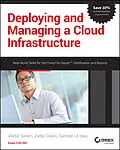Learn in-demand cloud computing skills from industry experts
Deploying and Managing a Cloud Infrastructure is an excellent resource for IT professionals seeking to tap into the demand for cloud administrators. This book helps prepare candidates for the CompTIA Cloud+ Certification (CV0-001) cloud computing certification exam. Designed for IT professionals with 2-3 years of networking experience, this certification provides validation of your cloud infrastructure knowledge.
With over 30 years of combined experience in cloud computing, the author team provides the latest expert perspectives on enterprise-level mobile computing, and covers the most essential topics for building and maintaining cloud-based systems, including:
* Understanding basic cloud-related computing concepts, terminology, and characteristics
* Identifying cloud delivery solutions and deploying new infrastructure
* Managing cloud technologies, services, and networks
* Monitoring hardware and software performance
Featuring real-world examples and interactive exercises, Deploying and Managing Cloud Infrastructure delivers practical knowledge you can apply immediately. And, in addition, you also get access to a full set of electronic study tools including:
* Interactive Test Environment
* Electronic Flashcards
* Glossary of Key Terms
Now is the time to learn the cloud computing skills you need to take that next step in your IT career.
Autorentext
ABOUT THE AUTHOR(S)
Abdul Salam is a senior consultant with Energy Services,
and author of numerous blogs, books, white papers, and tutorials on
cloud computing. He earned his bachelor's degree in
Information Technology, followed by an MBA-IT degree and
certifications by Cisco and Juniper Networks. He's a frequent
contributor to CloudTweaks.com. Zafar Gilani is an IT
specialist at GfK, Nuremberg. He was an Erasmus Mundus scholar at
Universitat Politècnica de Catalunya (UPC) and Kungliga
Tekniska högskolan (KTH), with postgraduate studies focused on
distributed computing. Salman UI Haq is co-founder and CEO
of TunaCode, Inc, which delivers GPU-accelerated computing
solutions to time-critical application domains. He's a
frequent CloudTweaks.com contributor, and holds a degree in
Computer Systems Engineering.
Zusammenfassung
Learn in-demand cloud computing skills from industry experts
Deploying and Managing a Cloud Infrastructure is an excellent resource for IT professionals seeking to tap into the demand for cloud administrators. This book helps prepare candidates for the CompTIA Cloud+ Certification (CV0-001) cloud computing certification exam. Designed for IT professionals with 2-3 years of networking experience, this certification provides validation of your cloud infrastructure knowledge.
With over 30 years of combined experience in cloud computing, the author team provides the latest expert perspectives on enterprise-level mobile computing, and covers the most essential topics for building and maintaining cloud-based systems, including:
- Understanding basic cloud-related computing concepts, terminology, and characteristics
- Identifying cloud delivery solutions and deploying new infrastructure
- Managing cloud technologies, services, and networks
- Monitoring hardware and software performance
Featuring real-world examples and interactive exercises, Deploying and Managing Cloud Infrastructure delivers practical knowledge you can apply immediately. And, in addition, you also get access to a full set of electronic study tools including:
- Interactive Test Environment
- Electronic Flashcards
- Glossary of Key Terms
Now is the time to learn the cloud computing skills you need to take that next step in your IT career.
Inhalt
Introduction xxiii
Chapter 1 Understanding Cloud Characteristics 1
Basic Terms and Characteristics 2
Elasticity 2
On-Demand Self-service/JIT 3
Templating 4
Pay as You Grow 6
Pay-as-You-Grow Theory vs. Practice 7
Chargeback 8
Ubiquitous Access 9
Metering Resource Pooling 10
Multitenancy 11
Cloud Bursting 13
Rapid Deployment 14
Object Storage Concepts 16
File-Based Data Storage 16
Object Storage 18
Structured vs. Unstructured Data 18
REST APIs 19
Summary 25
Chapter Essentials 26
Chapter 2 To Grasp the CloudFundamental Concepts 27
The True Nature of the Cloud 28
Elastic 29
Massive 29
On Demand 29
Virtualized 30
Secure 30
Always Available 30
Virtualization and Scalability 31
The True Definer of Cloud Computing 32
Serving the Whole World 32
The Cloud Hypervisor 33
Type 1 and Type 2 33
Use Cases and Examples 34
Benefits of Hypervisors 35
Hypervisor Security Concerns 35
Proprietary vs. Open Source 36
Moore's Law, Increasing Performance, and Decreasing Enterprise Usage 36
Xen Cloud Platform (Open Source) 37
KVM (Open Source) 38
OpenVZ (Open Source) 38
VirtualBox (Open Source) 39
Citrix XenServer (Proprietary) 39
VMware vSphere/ESXi (Proprietary) 39
Microsoft Windows Server 2012 Hyper-V 41
Consumer vs. Enterprise Use 41
Workstation vs. Infrastructure 43
Key Benefits of Implementing Hypervisors 46
Shared Resources 46
Elasticity 46
Network and Application Isolation 47
Foundations of Cloud Computing 48
Infrastructure 48
Platform 49
Applications 50
Enabling Services 50
Summary 50
Chapter Essentials 51
Chapter 3 Within the Cloud: Technical Concepts of Cloud Computing 53
Technical Basics of Cloud and Scalable Computing 54
Defining a Data Center 55
Traditional vs. Cloud Hardware 62
Determining Cloud Data Center Hardware and Infrastructure 65
Optimization and the Bottom Line 70
The Cloud Infrastructure 78
Open Source 79
Proprietary 84
Summary 85
Chapter Essentials 86
Chapter 4 Cloud Management 87
Understanding Cloud Management Platforms 88
What It Means for Service Providers 90
Planning Your Cloud 90
Building Your Cloud 94
Running Your Cloud 95
What This Means for Customers 95
Service-Level Agreements 97
Policies and Procedures 97
Planning the Documentation of the Network and IP 98
Implementing Change Management Best Practices 100
Managing the Configuration 105
Managing Cloud Workloads 111
Managing Workloads Right on the Cloud 111
Managing Risk 112
Securing Data in the Cloud 113
Managing Devices 114
Virtualizing the Desktop 115
Enterprise Cloud Solution 116
Summary 116
Chapter Essentials 119
Chapter 5 Diagnosis and Performance Monitoring 121
Performance Concepts 122
Input/Output Operations per Second (IOPS) 123
Read vs. Write Files 124
File System Performance 125
Metadata Performance 127
Caching 130
Bandwidth 131
Throughput: Bandwidth Aggregation 132
Jumbo Frames 134
Network Latency 135
Hop Counts 136
Quality of Service (QoS) 137
Multipathing 137
